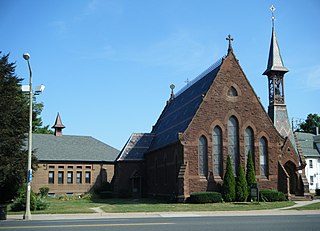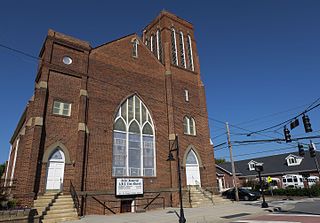
The Windsor Avenue Congregational Church is historic church at 2030 Main Street in Hartford, Connecticut. The brick Romanesque Revival-style church building, completed in 1872, now houses the Faith Congregational Church, whose lineage includes the city's oldest African-American congregation, established in 1819. The church is a stop on the Connecticut Freedom Trail and was listed on the United States National Register of Historic Places in 1993.

The Nast Trinity United Methodist Church is a historic congregation of the United Methodist Church in Cincinnati, Ohio, United States. Designed by leading Cincinnati architect Samuel Hannaford and completed in 1880, it was the home of the first German Methodist church to be established anywhere in the world, and it was declared a historic site in the late twentieth century.

The Northside United Methodist Church is a historic Methodist church in the Northside neighborhood of Cincinnati, Ohio, United States. Constructed in the 1890s for a congregation more than sixty years old, the building has been named a historic site.

The Methodist Episcopal Church is a historic church and parsonage at 61 East Putnam Avenue in Greenwich, Connecticut. Built in 1868-69 for a Methodist congregation established in 1805, the church is a fine local example of Carpenter Gothic architecture, and the parsonage, built in 1872, is a good example of Italianate architecture. The property was listed on the National Register of Historic Places in 1988. The congregation is affiliated with the United Methodist Church.

St. John's Episcopal Church is a historic church building at 1160 Main Street in East Hartford, Connecticut. It was designed by Edward T. Potter and was built in 1867, and is a prominent local example of High Gothic Revival executed in stone. Its congregation, begun as an Episcopal mission in 1854, has recently been merged into the St. John's Episcopal Church in Vernon. The building was listed on the National Register of Historic Places in 1983.

St. John's Episcopal Church is a historic church at 92 Main Street in the Warehouse Point section of East Windsor, Connecticut. Built in 1804, its interior was extensively restyled in the second half of the 19th century to resemble a Gothic English country church. The building, still in active use by the original congregation, was listed on the National Register of Historic Places in 1982.

Trinity Methodist Episcopal Church is a historic former church building at 69 Main Street in New Britain, Connecticut. Built in 1891 to a design by Amos P. Cutting, it is a distinctive local example of Richardsonian Romanesque architecture. Now a performing arts venue known as Trinity-on-Main, it was listed on the National Register of Historic Places in 2007.

The Methodist Episcopal Church of Winooski, also known as the Winooski United Methodist Church, is an historic Methodist church building located at 24 West Allen Street in Winooski, Vermont. It was built in 1918, and is a significant local example of vernacular Carpenter Gothic architecture. On March 2, 2001, it was added to the National Register of Historic Places.

Holy Trinity Episcopal Church also known as Holy Trinity Memorial Church is an historic Episcopal church building located at 38 Grand Avenue in the village of Swanton, Franklin County, Vermont. Built in 1876 and expanded in 1909-10, the church facilities include a fine example of the Carpenter Gothic in the older section, and the Late Victorian Gothic Revival in the newer section. The church was listed on the National Register of Historic Places as the Parish of the Holy Trinity in 2001. The church is an active parish in the Episcopal Diocese of Vermont; its current rector is the Rev. Reid D. Farrell.

St. Paul's Methodist Episcopal Church, known more recently as the Templo Sion Pentecostal Church, is a historic church at 1886-1906 Park Street in Hartford, Connecticut, United States. Built in 1900, it is a good example of Romanesque Revival design. It was built for a working-class congregation to a design by the nationally known church architect George W. Kramer, proponent of the Akron plan of church interiors, which this one follows. The church was added to the National Register of Historic Places in 1984.

The Union Baptist Church is a historic church at 1913 and 1921 Main Street in Hartford, Connecticut. Originally built by an Episcopal congregation, it has for many years been home to an African-American Baptist congregation, which under the leadership of Rev. John C. Jackson (1866-1953), played a significant role in advancing the cause of civil rights in the state. The church, and its adjacent parsonage, were listed on the National Register of Historic Places in 1979.

Wesley A.M.E. Zion Church is a historic church at 1500 Lombard Street in Philadelphia, Pennsylvania.

St. Peter's AME Zion Church is a historic African Methodist Episcopal church located at 615 Queen Street in New Bern, Craven County, North Carolina. It was built between 1923 and 1942, on the site of the 1914 church building which was destroyed by fire in 1922. It is a large three bay by seven bay, rectangular brick church building in the Late Gothic Revival style. It features a gabled nave flanked by two-story truncated stair towers. Also on the property is the contributing 1926 parsonage; a 2 1/2-story, frame American Craftsman style dwelling. It is known within the denomination as the "Mother Church of Zion Methodism in the South," and the oldest existing African Methodist Episcopal congregation in the South.

Evans Metropolitan AME Zion Church is a historic African Methodist Episcopal church located at 301 N. Cool Spring Street in Fayetteville, Cumberland County, North Carolina. It was built in 1893-1894, and is a five bay, rectangular brick building in the Gothic Revival style. The front facade features flanking towers. Also on the property is a contributing house built in 1913 used as an office/administration building. It is a two-story frame house with a hipped roof and wraparound porch.

Goler Memorial African Methodist Episcopal Zion Church, also known as Old Goler, is a historic African Methodist Episcopal Zion church located at 630 Patterson Avenue in Winston-Salem, Forsyth County, North Carolina. It was built in 1918-1919, and is a rectangular brick building in the Late Gothic Revival style. It features a gable-front block flanked by two square brick towers and stained glass windows. A two-story annex was built in 1946. In 1942, the Goler Metropolitan AME Zion Church congregation split from the Goler Memorial African Methodist Episcopal Zion Church.

Goler Metropolitan AME Zion Church, originally known as East Fourth Street Baptist Church, is a historic African Methodist Episcopal Zion church located at 1435 E. Fourth Street in Winston-Salem, Forsyth County, North Carolina. It was built in 1924, and is a front-gabled brick church with two prominent domed towers and flanking one-story hipped-roof wings in the Classical Revival style. The front facade features a prominent pedimented porch supported by stuccoed Doric order columns and Ionic order pilasters. The interior is based on the Akron Plan. The building was acquired by an African-American congregation split from the Goler Memorial African Methodist Episcopal Zion Church in 1942. The congregation changed their name to Goler Metropolitan A.M.E. Zion Church in 1953.

Center Street A.M.E. Zion Church is a historic African Methodist Episcopal Zion church located on S. Center Street in Statesville, Iredell County, North Carolina. It was built in 1903, and is a one-story, three bay by seven bay, Late Gothic Revival style brick building. It has a steep gable roof sheathed in pressed tin and features two corner entrance towers of unequal height and a large, pointed arch stained glass window.

Grace A.M.E. Zion Church is a historic African Methodist Episcopal Zion church located at 219-223 S. Brevard Street in Charlotte, Mecklenburg County, North Carolina. It was built in 1901-1902, and is a Gothic Revival style brick church. The front facade features two crenellated entry towers of unequal height with matching Gothic arched entrances. It is one of the oldest of the remaining African American churches associated with Charlotte's historic black districts.

Mt. Zion Christian Methodist Episcopal Church, formerly Mt. Zion Colored Methodist Episcopal Church, is a historic African-American church in Union City, Tennessee, at the corner of North Greenwood and East College Streets.

The Little Bethel African Methodist Episcopal Church, now the Bethel African Methodist Episcopal Church, is a historic church building and congregation at 44 Lake Avenue in Greenwich, Connecticut, United States. Founded in 1882, the congregation was Greenwich's first African-American congregation of any denomination, and remains a center of African-American society in the town. Its current church, built in 1921 on the site of its first church, is a good example of Late Gothic Revival architecture, and was listed on the National Register of Historic Places in 2010.



























